Report of the State's Attorney for the Judicial District of Windham Concerning the Use of Deadly Physical Force by a Willimantic Police Officer on March 12, 2013, in Willimantic, CT
Preface | Summary of Evidence | Cause of Death and Other Findings | Applicable Law | Legal Conclusion |Attachments
Pursuant to Section 51-277a of the Connecticut General Statutes, Patricia M. Froehlich, State’s Attorney for the Judicial District of Windham has prepared this report concerning the shooting death of Daniel Johnston, date of birth December 22, 1955, shortly after 8:00 p.m. in Willimantic, CT on March 12, 2013. The undersigned State’s Attorney requested that the Connecticut State Police Eastern District Major Crime Squad conduct the investigation into Mr. Johnston’s death. This report and its conclusions are based upon the thorough investigation conducted by the Eastern District Major Crime Squad, in conjunction with the Division of Scientific Services, the Office of the Chief Medical Examiner, and with the cooperation of the Willimantic Police Department and members of the Office of the State’s Attorney for the Judicial District of Windham. The undersigned State’s Attorney and Inspector Michael Hurley of the Windham State’s Attorney’s Office went to and observed the scene of the shooting on the night of March 12, 2013. The documentation of this investigation included sworn, written statements from the original complainants and other civilian witnesses. The Willimantic Police Officers did not submit to interviews or provide sworn, written statements. Instead, they prepared incident reports describing their observations and activities. The undersigned has reviewed and summarized below the extensive documentation of this investigation.
The investigation revealed that Officer Aaron Brais fired the lethal shot at Daniel Johnston after Daniel Johnston threatened the use of deadly force in an exterior alcove of the building at 461 Main Street, Willimantic.
The loss of life, particularly in a violent manner, is tragic. The undersigned extends her condolences to the family and friends of Daniel Johnston.
461 Main Street, Willimantic, is a multilevel, multipurpose building. The front, or south, side of the building faces Main Street and is at street level. A business called Doggy Stylzes is on the first floor facing Main Street. On the west side of the building is Clark Street, which runs up an incline northerly from Main Street. On the rear, or north, side of the building is a narrow driveway that runs in an easterly direction from Clark Street and leads to an exterior stairway and an area which may be described as an alcove, a porch, a patio or a balcony. This stairway leads to residential apartments on the second floor and third floors. Apartment five is directly above apartment three. The alcove provides access to an interior hallway as well as an exterior door to apartment number three. The other apartments on the second floor do not have entrances on the Clark Street side of the building, but apartment number three has two entrances
The exterior stairway and alcove is an area approximately 10 feet deep by 12 feet wide. The exterior stairway itself is three feet wide and cuts the alcove into two main sections. There is approximately four feet of space between the south wall of the alcove and the bottom of the staircase. To the east of the staircase is a walkway leading to the driveway, which is located on the Clark Street side of the building. The walkway is approximately 16 feet deep from north to south and as much as three feet wide from east to west. A diagram of the area is included with this report.
There is overhead lighting within the stairway/alcove area; the walls and 7’3" ceiling are painted white.
Jamilette Vargas and Ramon Castillo lived in Apartment 5 at 461 Main Street, along with Jamilette’s young daughter. In late February or early March a person unknown to Jamilette and Ramon moved into the apartment below, which Jamilette believed to be apartment number three. On March 12, 2013 the couple and the child were in their apartment when at approximately 7:00 p.m. Jamilette heard a voice, causing her to look outside. She saw a heavy set, tall white male, wearing glasses. She had never seen him before. Ramon, too, heard banging that sounded like it was coming from the apartment below theirs; he said it was at about 6:40 p.m. A short time later, the couple and child were preparing to leave their apartment. Jamilette and her daughter walked outside while Ramon was locking their apartment door. As Jamilette was walking down the exterior stairs she heard a male say "I don’t think that’s a good idea." She turned to see a male standing in the doorway to apartment number three. It was the same man she had seen earlier. The door to the apartment was open and the apartment was dark. The man had something in his hands, resting on his shoulder, although Jamilette could not tell at the time what it was. She said that he just kept looking at her and that "something didn’t look right, it was like a movie, this male had a look on his face like he was looking right through me." As Ramon was locking the door he heard a male voice down below sounding very angry and yelling "It’s not a good idea." Ramon did not know who the man was talking to. As he walked down the stairs Ramon saw a white male standing in the open doorway of the apartment below his. He did not see anyone else in the area outside 461 Main Street. Ramon said the man was about 6’0" tall, weighed about 300 pounds and was wearing glasses. He did not notice what the man was wearing, nor does he recall specifically what the glasses looked like because he saw that the man was holding a large weapon and had another large weapon in his waistband. Ramon said the first weapon was a large, medieval looking axe with a black handle; he thought the blade was also black. Ramon said the handle was about 2 ½ feet long, and the blade, which was about 8 inches by 12 inches, looked like it was sharpened on both sides. He said the man was holding the "very intimidating looking" axe in his right hand with the blade above his shoulder. Ramon said the man looked like he was "on something, meaning some sort of drugs, or that he was not right in the head," and that he seemed very angry and aggressive. Jamilette walked to the car and saw Ramon walking down the stairs behind her. Ramon said that as he was walking down the stairs he heard the man ask "Are you the tough guy?" in a "very strong intimidating voice like he wanted a confrontation." While saying this the man walked to within two to three feet of Ramon. Ramon said "I am not the tough guy" and walked rapidly away from the man. Ramon saw a second weapon in the man’s waistband; it had a brown wood handle about one foot long and although he could not see the blade Ramon said it looked like the handle to a machete or a very large knife. Meanwhile, Jamilette was waving rapidly and saying "vente, vente," which means come here in Spanish. Jamilette said she did so because the man had an axe in his hands and it was resting on his shoulder. She said that the axe was a couple of feet long and had a black handle and she was immediately scared for her life and those of her family. Ramon said that when the man was approaching him with the weapon he had great fear for his own life and for the lives of Jamilette and the child.
As soon as Jamilette and Ramon got in Ramon’s car they drove away and called the apartment maintenance worker, who told them to report it to the police. Ramon and Jamilette drove to the Willimantic Police Department.
The above details are taken from sworn written statements Jamilette Vargas and Ramon Castillo provided to a Connecticut State Police detective just a few hours after the shooting. Officer Elvin Salas of the Willimantic Police Department translated Ms. Vargas’ statement from Spanish to English.
Ms. Vargas and Mr. Castillo reported to a Willimantic Police dispatcher that a white male holding an axe-type object in one of his hands also had a knife secured to his person. As a result, Corporal Alex Coriaty returned from patrol at approximately 7:53 p.m. to meet with Mr. Castillo and Ms. Vargas.
After hearing the initial complaint, Corporal Coriaty requested that the entire evening shift, which consisted of Officers Amy Hartman, Joshua Clark, Michael Suplicki, Aaron Brais and Jonathan John report to police headquarters where he briefed them on this situation. Patrol Commander Lt. Evans attended the briefing for a short period of time but left to respond to an unrelated call for service. Officers Clark, Suplicki, Brais and John are members of the Department’s Special Operations Group (SOG) and have specialized training in weapons and tactics. All officers at the briefing discussed the manner in which they would approach the residence, locate the suspect, and address the complaint.
Once they devised a plan and tactical approach, the six officers traveled in three patrol cars, which they parked at the intersection of Union and Clark Streets. From there they walked to 461 Main Street. Five of the officers were wearing Willimantic police department uniforms, badges, and name tags, making them readily identifiable as police officers. Officer John was wearing Willimantic police department’s canine officer attire, which included the department name and his name, making him readily identifiable as a police officer. He left the canine in the vehicle.
All officers and the owner of Doggy Stylzes grooming salon said that the officers entered the building through Doggy Stylzes. Salon owner Joshua Hoenig later told the State Police that he had heard a male yelling sometime after 6:30 p.m. Although he could not make out what the man was saying, it sounded like it was coming from one of the apartments above the grooming salon. Mr. Hoenig showed the officers how to get to the apartments via a common hallway and stairwell located in the back of the salon. He then returned to his salon, from which he could hearing knocking on a door from the upstairs apartments once the police went up the stairs.
The officers went to the second floor and located apartment number three on the left as they exited the stairwell. There were no people in the hallway. The officers positioned themselves in a safe manner outside the door to apartment number three. Officer Suplicki was initially positioned to the right of the door, with Corporal Coriaty to the left of the door, closest to the door knob. Officer Brais was initially directly behind Corporal Coriaty, followed by Officers John, Suplicki, Clark and Hartman. Because of the nature of the complaint, all officers had their duty weapons drawn but pointing down in a ready position.
Corporal Coriaty checked the door knob, which was locked. When he knocked on the door a man from within the apartment responded by saying "no one lives here but the cockroaches." When he knocked for the second time Corporal Coriaty identified himself as the "police." For the second time the man responded by saying "no one lives here but the cockroaches." The third time Corporal Coriaty knocked he announced not only "police," but also "please come to the door."
By this time Officer Brais had repositioned himself behind Officer Suplicki, closest to a crash bar door which led to the exterior stairwell/porch.
In response to Corporal Coriaty’s third knock, the man inside the apartment responded not just "no one lives here but the cockroaches," but also "if you want me, come and get me, the door is open."
Officer Brais pushed on the crash bar door and discovered that there was a second door to apartment three, making it accessible from the exterior stairwell, and that this door was wide open.
Officer Brais then led the officers into the exterior stairwell, which is a confined area. To the left of the apartment door was a railing. Officer Brais was closest to the apartment’s open door; Officer Clark was closest to the railing. Officer Suplicki was to the left, rear of Officer Brais, Officer John was behind Officer Suplicki and reported that he could not see the man but could hear the sound of heavy footsteps moving quickly toward them. Officer Hartman was securing the rear of the line of officers. From her position she heard an officer knock on the door and what sounded to be a male’s voice responding but was unable to hear specifically what the occupant said. She reported that she heard an officer knock a second time, as well as a second response but again was unable to hear what was said. The interior of apartment three was completely dark. Officers announced their presence. A person in the doorway of the darkened apartment would be able to see the officers in the lighted balcony area. Officer Brais turned on the weapon light issued with his department firearm. It illuminated an area immediately inside the apartment door. Corporal Coriaty, Officer Clark and Officer Brais could see a man standing inside the entry to the apartment. Officer Brais saw a heavy set white male standing to the left side of the doorway, just inside the apartment door and behind a left hand wall or corner. The man’s body was bladed to the side, leaning slightly forward but apparently trying to conceal as much of his body as possible, peaking only his head around the corner. Officer Brais saw that the man had his hand next to his sternum; his hand was holding the base of a thin shaft-like object which extended up toward his shoulder and around the corner, out of Officer Brais’ view. Based on the information from the complainants, Officer Brais believed that the shaft-like object was the base of the axe-type weapon. He did not attempt to enter the apartment because he believed the man’s invitation to do so was based on his intent to ambush the officers and strike Officer Brais or other officers with the axe, which could have inflicted serious injury, maimed or killed one of the officers. The man made eye contact with Officer Brais and then immediately stepped out from around the corner and into full view, at which time Officer Brais was able to see that the shaft was the handle portion of an axe-type weapon. Without hesitating, the man immediately leaned his shoulders forward and began to charge toward Officer Brais as Officer Brais was shouting "Police. Drop the knife." Rather than dropping the weapon, the man continued to charge forward, raising his hand up next to his head, elevating the axe over his head preparing to swing while Officer Brais continued shouting "Drop the Knife."
Corporal Coriaty could see the man holding an axe-type object above his head as if he was about to strike the officers. Corporal Coriaty and Officer Suplicki saw the man moving quickly, also described as "rapidly charging" toward Officer Brais. Officer Clark immediately deployed his Willimantic Police Department Taser as a less than lethal effort to subdue the man. Despite the fact that the probes struck the man, he was not incapacitated but instead continued to advance toward the officers with the axe raised above his head.
Officer Hartman heard an officer yelling commands to "Drop the weapon" at least two times. Due to her position, with other officers positioned in front of her, as well as the large concrete staircase, she was at first unable to see into the apartment or the person to whom the commands were being directed. In an attempt to get a clear line of sight into the interior of the apartment and of the suspect, she began to move around the concrete stairwell. While moving, she looked into the apartment and saw a heavy set white male standing inside with his arm raised up above his head. Because her view into the apartment was partially obstructed by the stairwell she was unable to see if the man was holding anything in his hand.
Officer Brais later reported that he had a clear and unobstructed view of the axe and saw not a typical utility axe but rather one with dual sharpened heads so that both sides of the axe could seriously impair, disfigure, decapitate or kill someone. Officer Brais also reported that the man was approximately 10 feet away but continued to charge forward with the deadly axe elevated over his head. Officer Brais feared that if the man reached him he intended to swing or throw the axe and believed that if the man did so he (Officer Brais) would be seriously injured, maimed or killed.
Officer Brais fired at the man’s chest as he simultaneously began stepping backwards away from the man. He saw that the first two rounds struck the man in the chest. The man, however, still armed with the axe, continued toward Officer Brais. Officer Brais fired one more time but did not see where the third round struck because Officer Brais was lowering his head, thinking the man was going to reach him and be able to effectively strike him with the axe.
Officer Suplicki reported that it was only after the third shot that the man dropped what he described as a "battle axe" and fell to the ground directly at his feet. Officer Brais reported that when the man fell he kicked the axe out of the man’s hand and away. Officer Hartman heard three "pops" and saw three shell casings bounce across the concrete stairs toward her face. As she continued to move around the staircase she saw a man lying face down on the concrete balcony floor. She saw Officer Suplicki check the man for weapons and remove a sheath located on the man’s belt. The sheath contained what appeared to be a knife. Officer Hartman saw Officer Brais kick away an axe the man was holding.
Officer Brais reported that he did not hear the Taser discharge during the incident but saw the Taser leads draped across the floor and next to the man as he was removing the second, straight blade knife from a sheath attached to the man’s hip.
Both Officer Brais and Corporal Coriaty called for medical personnel.
Officers John & Suplicki searched the apartment to be sure there was no one else within, either assailant, hostage, or victim. No one else was present.
Willimantic Police secured the scene; Corporal Coriaty took possession of Officer Brais’ service weapon, which was later turned over to a Connecticut State Police detective. This department-issued weapon is a .45 caliber Glock semiautomatic pistol.
Daniel Johnston was transported via ambulance to Windham Hospital, where he was pronounced dead at 9:14 p.m. on March 12, 2013.
Joshua Hoenig, owner of the Doggy Stylzes Grooming Salon, said that about 10 minutes after he showed the officers the back stairs, he was standing outside near the front door of his salon when he clearly heard the male officer in the back of the building say two times "Drop your weapon, Drop your weapon." He said that he then heard four loud, quick gun shots coming from the rear of the building. Mr. Hoenig provided this information in a sworn written statement he gave to a Connecticut State Police detective at approximately 11:30 p.m. on March 12, 2013.
Marisol Sanchez lived in apartment number four at 461 Main Street, Willimantic. On Tuesday, March 12, 2013 at approximately 6:30 p.m. she and her husband, Angel Rosado, were in their apartment when they heard people briefly arguing outside the building. Ms. Sanchez said that approximately a half hour later she heard three gunshots coming from the rear of the building. Her husband called the Willimantic Police to report the gunshots but was informed that the police were already in the building. Ms. Sanchez provided this information in a sworn written statement she gave to a Connecticut State Police detective within a few hours after the shooting.
Maria Pedraca, of 119 Union Street, Willimantic, said that she heard three gunshots while watching TV at her home at approximately 9:00 p.m. on March 12, 2013. She looked outside and saw several police cruisers parked on Clark Street near its intersection with Main Street. Ms. Pedraca provided this information in a sworn written statement she gave to a Connecticut State Police detective at approximately 11:00 a.m. on March 13, 2013.
CAUSE OF DEATH AND OTHER FINDINGS
Daniel Johnston’s body was transported to the Office of the Chief Medical Examiner in Farmington. On March 15, 2013, H. Wayne Carver, M.D., conducted a post-mortem examination in the presence of Connecticut State Police Detectives Ryan Luther and Daniel Cargill. Daniel Johnston was positively identified by comparing his post-mortem fingerprints to pre-mortem fingerprints maintained by the Federal Bureau of Investigation. On September 4, 2013, James R. Gill, M.D., Chief Medical Examiner sent the autopsy report, toxicology report, Identification form and Receipt of Evidence to the Eastern District Major Crime Squad.
Toxicological analysis revealed no alcohol, acidic/neutral drugs, basic drugs, cocaine metabolite, opiates or oxycodone in samples taken from Daniel Johnston’s body.
Dr. Carver found that Daniel Johnston was 71 inches tall and weighed 315 pounds. Dr. Carver removed three projectiles from Daniel Johnston’s body. Dr. Carver found that the cause of death was multiple gunshot wounds: a "gunshot wound of neck with injury to the right lung and diaphragm, two gunshot wounds of chest." Neither soot nor powder stippling was noted at the location of any of the gunshot wounds. Dr. Carver also found that the manner of death was homicide.
The above documentation of the investigation revealed that Officer Joshua Clark deployed his department issued Taser in an effort to stop the man from attacking the officers. Of the six Willimantic Police Officers who responded to the complaint of a man threatening neighbors with a large axe-like weapon, only Officer Brais discharged his department-issued firearm.
Officer Brais was carrying and discharged a .45 caliber Glock semi-automatic pistol. On or about March 20, 2013, Willimantic Police Captain Clifford Spinner provided an Eastern District Major Crime Squad detective with two pages from the Department’s Rules and Regulations, along with a title page. These rules and regulations are dated April, 1976. The firearms section states that members of the department shall be equipped by the department with .38 Special Revolvers and that "an officer shall not carry a non-regulation firearm on duty without approval of the Chief of Police." Firearms Qualification records for Officer Aaron Brais reveal that he was consistently and satisfactorily trained by the Willimantic Police Department in the use of a .45 caliber Glock pistol. These training records require and reflect the signature of the Department head, Chief Lisa Maruzo Bolduc.
Thus, the undersigned has drawn the reasonable and logical inference that the Chief of Police approved the use of the .45 caliber Glock semi-automatic pistol in place of the .38 Special Revolver described in the Department’s 1976 Rules and Regulations.
The State Police Firearms Survey revealed that the weapon issued to and fired by Officer Brais had a capacity of 13 rounds and that three rounds had been fired. This is corroborated by the fact that Officer Harman saw three shell casings bounce across the floor toward her immediately after the shooting and by the fact that the Eastern District Major Crime Squad recognized, collected and documented three .45 caliber spent shell casings from the landing area outside apartment number three at 461 Main Street. It is also corroborated by the fact that three projectiles were removed from Daniel Johnston’s body during autopsy at the Office of the Chief Medical Examiner.
Officer Brais reported that the man was approximately 10 feet away from him but continuing to approach when Officer Brais began to fire his department issued weapon. This is corroborated by the lack of gunpowder around any of the deceased’s wounds, as typically a shot fired from as little as three feet away is considered long range and will leave little gunpowder residue. Shots fired from greater than three feet away from the target will typically leave no gunpowder residue.
The menacing black hatchet/axe that Daniel Johnston brandished in a threatening manner measured approximately 18 ¾ inches, with the head measuring approximately 8 ¾ inches in width. Photographs of this weapon are included with this report. The knife that civilian and police witnesses saw in a sheath on Daniel Johnston’s person was a wood handled, machete-type knife with a blade measuring approximately 17 ¼ inches in length and a maximum of approximately 2 ½ inches wide. The same sheath also contained two smaller knives in a plastic bag. Photographs of this weapon are included with this report. The Division of Scientific Services examined and processed the weapons but did not develop or find any identifiable latent fingerprint impressions on them. Results of DNA analysis were consistent with Daniel Johnston being the source of the DNA profiles on the hatchet, hatchet handle and knife handle.
At approximately 1:15 a.m. on March 13, 2013, John Walker, the owner of 461 Main Street, provided State Police detectives with written consent to search the building in its entirety. In addition to the three spent shell casings, the police also located in the area of the shooting a pair of broken eyeglasses, corroborating the complainants’ initial description of the man who threatened them with the axe. In an effort to gather information about the man who had brandished the weapon, detectives conducted a survey of apartment three. On the kitchen table, along with mail addressed to Daniel Johnston, they discovered a receipt from Smoky Mountain Knife Works for an order dated February 28, 2013. In a bedroom filing cabinet the detectives found paperwork titled "Inmate Status Report for Parole Board Appearance" regarding a 1990 New York incident in which Daniel Johnston held two women hostage. The report indicates that Daniel Johnston was suicidal and wanted police to shoot him because he couldn’t shoot himself. At that time Daniel Johnston was armed with a .22 caliber pistol, a .45 caliber pistol and two knives.
The purpose of this investigation is to determine whether Office Brais’ use of deadly force was appropriate under Section 53a-22 of the Connecticut General Statutes. More specifically, it is the law regarding a peace officer’s use of deadly physical force upon another person as set forth in Section 53a-22(c)(1) that controls whether Office Brais was justified when he used deadly physical force on March 12, 2013. Section 53a-22(c) states, in pertinent part, that "a peace officer … is justified in using deadly physical force upon another person only when he reasonably believes such to be necessary to: (1) Defend himself or a third person from the use or imminent use of deadly physical force …." (emphasis added).
The test to determine reasonableness is both subjective and objective. First, the officer must believe that the use of deadly force is necessary to defend himself or another from the imminent use of deadly physical force. Second, the belief must be objectively reasonable. See State v. Smith, 73 Conn. App. 173, cert. denied, 262 Conn. 923 (2002).
The test is not whether it was in fact necessary for the officer to use deadly physical force in order to defend against the imminent use of deadly physical force. The test is whether the officer believed it was necessary to use deadly physical force and whether such belief was objectively reasonable based on the facts and circumstances known to the police officer at the time the decision to use deadly force was made. See State v. Silveira, 198 Conn. 454 (1986), State v. Adams, 52 Conn. App. 643 (1999).
"The ‘reasonableness’ of a particular use of force must be judged from the perspective of a reasonable officer on scene rather than with the 20/20 vision of hindsight. The calculus of reasonableness must embody allowance of the fact that police officers are often forced to make split-second decisions - in circumstances that are tense, uncertain, and rapidly evolving - about the amount of force that is necessary in a particular situation." Graham v. Connor , 490 U.S. 386 (1989).
"The appropriate inquiry is whether the officers acted reasonably, not whether they had less intrusive alternatives available to them." Scott v. Henrich, 39 F.3d. 912, 915 (9th Cir. 1992).
Daniel Johnston threatened Officer Aaron Brais, a peace officer, with deadly physical force. Officer Brais reasonably feared that the man could swing or throw the axe at him or another officer. Because of the limited size of the balcony, Officer Brais had few, if any, options. There was no escape path; the man refused to obey repeated commands to drop the weapon. The man continued advancing upon the officer with the axe poised and ready to strike.
This conclusion is based solely on facts available to Officer Brais at the time he discharged his firearm. The above reference to items found in Daniel Johnston’s apartment is intended solely to provide a more thorough picture for those who may be interested in what motivated Mr. Johnston to threaten neighbors with whom he had no previous relationship.
Officer Brais was forced to make a split-second decision and reasonably believed that it was necessary to use deadly physical force to defend himself and other Willimantic officers from Daniel Johnston’s imminent use of deadly physical force.
After a complete review of the facts, the undersigned has concluded that the use of deadly force was justified.
The Division of Criminal Justice will take no further action with respect to the use of deadly force in this incident.
Respectfully submitted,
Patricia M. Froehlich
State’s Attorney
Judicial District of Windham
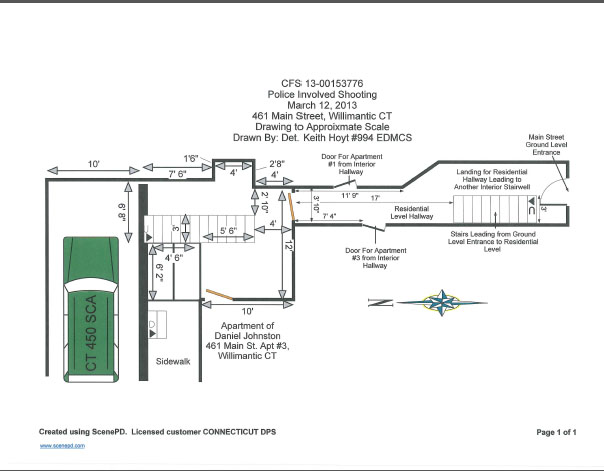 |
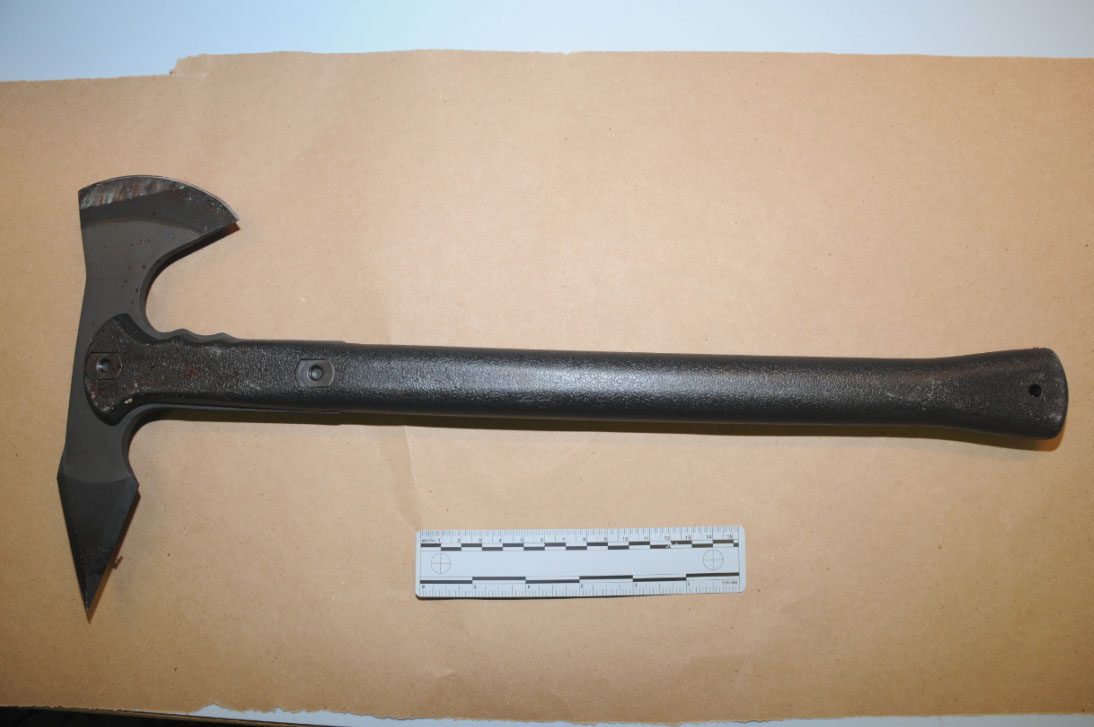 |
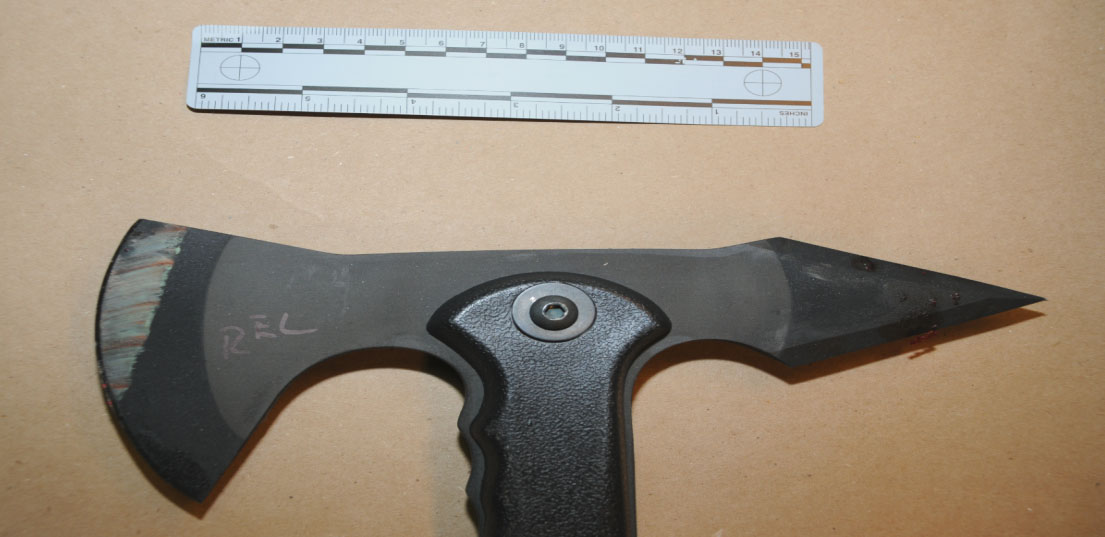 |
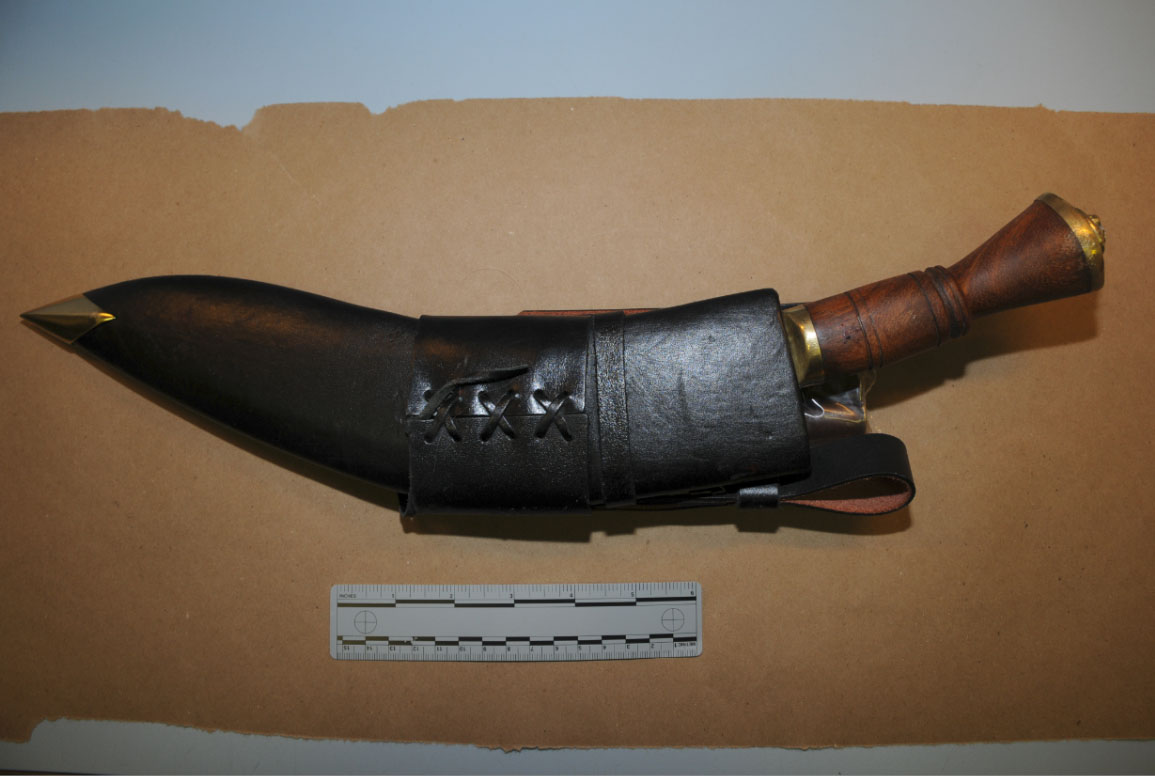 |
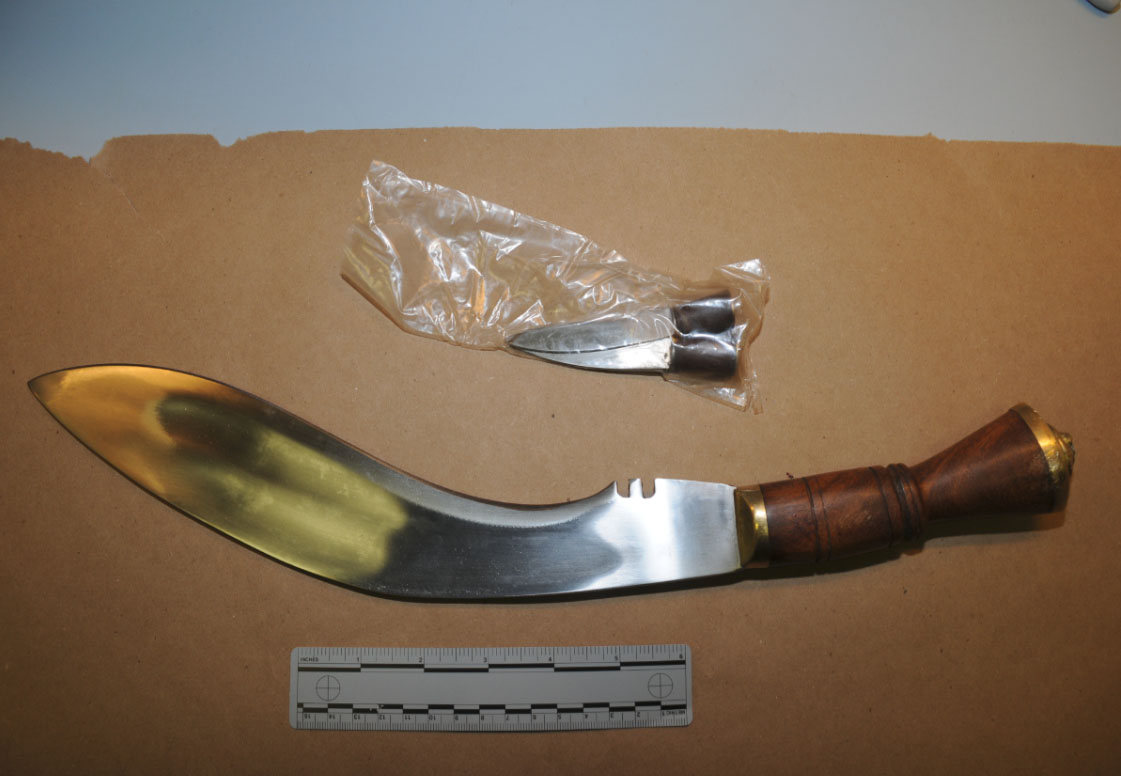 |

